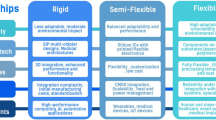Abstract
In this paper, the system on display panel (SoDP) architecture, the primary stage of heterogeneous integration system in display (HiSID), is introduced for the first time. In this architecture, the driving components of display, which are supposed to be on the display flexible print circuit (FPC) in traditional architecture, are innovatively integrated onto the backside of display panel. Through the SoDP architecture, the simulated impact strain in the panel fan-out region can decrease about 30% compared to the traditional architecture, and SoDP provides more the 10 mm extra space in the in-plane Y-direction for holding a larger battery. Also, the SoDP is compatible with the current organic laser emitted diode (OLED) and system in package (SiP) processes. Besides the primary stage, this paper also presents a comprehensive and extensive analysis on the challenges of the manufacturability for the advanced stage of HiSID from four key technologies perspectives: device miniaturization, massive manufacturing, driving technology, and advanced heterogeneous integration.










Similar content being viewed by others
Explore related subjects
Discover the latest articles and news from researchers in related subjects, suggested using machine learning.References
Long HH, Zhang L, Ma HC et al (2022) Heterogeneous integration system in display (HiSID) for next generation terminal device. IEEE Trans Compon Packag Manuf 12:731–739
Long HH, Zhang L, Ma H, Sun Y. Display apparatus, manufacturing method for display apparatus and electronic device. China Patent CN202210397251.2
Ryu HY, Kim HS, Shim JL (2009) Rate equation analysis of efficiency droop in InGaN light-emitting diodes. Appl Phys Lett 95(8):081114. https://doi.org/10.1063/1.3216578
Olivier F, Daami A, Dupré L et al (2017) 25-4: Investigation and improvement of 10 µm pixel-pitch GaN-based micro-LED arrays with very high brightness. SID Symp Dig Tech Pap 48(1):353–356
Hwang D, Mughal A, Pynn CD et al (2017) Sustained high external quantum efficiency in ultrasmall blue III–nitride micro-LEDs. Appl Phys Express 10(3):032101. https://doi.org/10.7567/APEX.10.032101
Olivier F, Tirano S, Dupré L et al (2017) Influence of size-reduction on the performances of GaN-based micro-LEDs for display application. J Lumin 191:112–116
Eric HV, Nicolas B (2018) 45-1: Status and prospects of microLED displays. SID Int Symp Dig Tech Pap 49(1):593–596
Chen WJ, Hu GH, Lin JL et al (2015) High-performance, single-pyramid micro light-emitting diode with leakage current confinement layer. Appl Phys Express 8(3):032102. https://doi.org/10.7567/APEX.8.032102
Wong MS, David H, Alhassan AI et al (2018) High efficiency of III-nitride micro-light-emitting diodes by sidewall passivation using atomic layer deposition. Opt Express 26(16):21324. https://doi.org/10.1364/OE.26.021324
Tseng E, Colburn S, Whitehead J et al (2021) Neural nano-optics for high-quality thin lens imaging. Nat Commun 12:6493. https://doi.org/10.5281/zenodo.5637678
Zhang L, Ou F, Chong WC et al (2018) Wafer-scale monolithic hybrid integration of Si-based IC and III-V epi-layers—a mass manufacturable approach for active matrix micro-LED micro-displays. J Soc Inf Disp 26(3):137–145
Cok RS, Meitl M, Rotzoll R et al (2017) Inorganic light-emitting diode displays using micro-transfer printing. J Soc Inf Disp 25(10):589–609
Corbett B, Loi R, Zhou W et al (2017) Transfer print techniques for heterogeneous integration of photonic components. Prog Quant Electron 52:1–17
Meitl MA, Zhu ZT, Kumar V et al (2006) Transfer printing by kinetic control of adhesion to an elastomeric stamp. Nat Mater 5:33–38
Feng X, Meitl MA, Bowen AM et al (2007) Competing fracture in kinetically controlled transfer printing. Langmuir 23(25):12555–12560
Long HH, She Y, Wei SS et al (2020) Chip transfer method and electronic equipment. China Patent CN112038280A
Delaporte P, Alloncle AP (2016) Laser-induced forward transfer: a high resolution additive manufacturing technology. Opt Laser Technol 78:33–41
Xia JY, Cao XA, Long HH (2021) A kind of driving backplane, display and electronic. China Patent CN214956885U
Yeo KS, Ng WX, Soh MY et al (2017) Micro-LED arrays for display and communication: device structure and driver architecture. In: 2017 IEEE 12th international conference on ASIC (ASICON), pp 993–996, 25–28 Oct, Guiyang
Topper M, Ndip I, Erxleben R et al (2010) 3-D thin film interposer based on TGV (through glass vias): an alternative to Si-interposer. In: IEEE electronic components and technology conference, pp 66–73, 1–4 June, Las Vegas
Kwon SG, Kang J, Back S et al (2020) Rapid electronic interconnection across glass boundary edge for sustainable and lean electronics manufacturing. ACS Sustain Chem Eng 8(30):11348–11357
3D system integration program: W2W bonding, IMEC, 2018
YMTC 3D NAND memory, systemplus, SP20562 report
2.5D &3D TSV and Wafer-Level stacking Technology and Market Update, Yole, 2019, YD19004 report
Lee TK, Thomas RB, Kim CU et al (2015) Fundamentals of lead-free solder interconnect technology: from microstructures to reliability. Springer
Author information
Authors and Affiliations
Corresponding author
Rights and permissions
Springer Nature or its licensor holds exclusive rights to this article under a publishing agreement with the author(s) or other rightsholder(s); author self-archiving of the accepted manuscript version of this article is solely governed by the terms of such publishing agreement and applicable law.
About this article
Cite this article
Long, HH., Ma, HC., Gao, JY. et al. Manufacturability and mechanical reliability study for heterogeneous integration system in display (HiSID). Adv. Manuf. 11, 191–202 (2023). https://doi.org/10.1007/s40436-022-00420-2
Received:
Revised:
Accepted:
Published:
Issue Date:
DOI: https://doi.org/10.1007/s40436-022-00420-2




